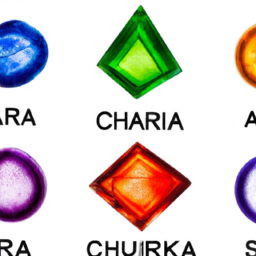
Chakras, also known as energy centers, have been a topic of interest in many spiritual practices and belief systems. They are believed to be the source of our physical, emotional, and spiritual well-being, and their proper alignment is considered crucial for a balanced and harmonious life.
But where do chakras actually originate? In this article, we will delve into the origins of chakras and explore their significance in our lives.
The History of Chakras
The concept of chakras can be traced back to ancient Indian texts, particularly the Vedas and Upanishads. These texts describe the existence of seven primary energy centers located along the spinal column, from the base of the spine to the top of the head.
The word chakra comes from the Sanskrit word which means “wheel” or ”circle”. This is because the energy centers are believed to spin, creating a vortex of energy within the body.
According to ancient Hindu philosophy, each chakra is associated with a specific color, sound, element, and emotion. The lower chakras are connected to our physical and emotional needs, while the higher chakras are related to our intuition and higher consciousness.
The Location and Functions of Each Chakra
1. Root Chakra (Muladhara)
The first chakra is located at the base of the spine and is associated with the color red. It is responsible for our sense of security, stability, and survival instincts.
When the root chakra is balanced, we feel grounded, secure, and able to fulfill our basic needs. Imbalances in this chakra can lead to feelings of fear, anxiety, and insecurity.
2. Sacral Chakra (Svadhishthana)
The second chakra is located just below the navel and is associated with the color orange. It is associated with our emotions, creativity, and sexuality.
A balanced sacral chakra allows us to express our feelings and desires freely, while imbalances can manifest in issues with intimacy, creativity, and emotional stability.
3. Solar Plexus Chakra (Manipura)
The third chakra is located above the navel and is associated with the color yellow. It is responsible for our self-esteem, personal power, and willpower.
A balanced solar plexus chakra enables us to have a strong sense of self-worth and confidence, while imbalances can manifest in feelings of low self-esteem, lack of motivation, and digestive issues.
4. Heart Chakra (Anahata)
The fourth chakra is located at the center of the chest and is associated with the color green. It is the bridge between our physical and spiritual selves and is responsible for our ability to love and connect with others.
A balanced heart chakra enables us to experience love, compassion, and forgiveness, while imbalances can manifest in difficulties with relationships, trust, and heart-related health issues.
5. Throat Chakra (Vishuddha)
The fifth chakra is located at the base of the throat and is associated with the color blue. It is responsible for our communication, self-expression, and ability to speak our truth.
A balanced throat chakra allows us to express ourselves effectively and confidently, while imbalances can lead to communication issues, social anxiety, and thyroid problems.
6. Third Eye Chakra (Ajna)
The sixth chakra is located between the eyebrows and is associated with the color indigo. It is known as the center of intuition and is responsible for our inner wisdom and spiritual insight.
A balanced third eye chakra enables us to trust our intuition and make decisions based on our inner knowing, while imbalances can result in feelings of confusion, lack of direction, and migraine headaches.
7. Crown Chakra (Sahasrara)
The seventh and final chakra is located at the top of the head and is associated with the color violet. It is considered the gateway to our spiritual connection and higher consciousness.
A balanced crown chakra allows us to experience a deep connection with the universe and our purpose in life, while imbalances can manifest in feelings of disconnection, lack of purpose, and spiritual blocks.
The Role of Chakras in Our Lives
Chakras are believed to be the source of our physical, emotional, and spiritual well-being. When all chakras are aligned and functioning properly, we can experience a sense of balance, harmony, and overall well-being.
But just like any other part of our body, our chakras can become imbalanced due to various factors such as stress, trauma, and negative thoughts. Therefore, it is important to regularly cleanse and balance our chakras to maintain their health and optimum functioning.
There are various methods and practices for chakra healing, such as meditation, yoga, and energy healing techniques like Reiki. These practices can help us clear any blockages in our chakras and restore their proper flow of energy.
In Conclusion
The concept of chakras may seem abstract and mysterious, but its origins can be traced back to ancient philosophy and texts. These energy centers are believed to play a significant role in our physical, emotional, and spiritual well-being, and keeping them balanced and aligned is crucial for a harmonious life.
By understanding the location and functions of each chakra, we can become more aware of our energy and work towards achieving balance in our lives. So next time someone asks you where chakras originate, you will have a deeper understanding and appreciation of their existence.





Intriguing to learn of their origin!
MelissaH: I’m curious to learn more!
This is an exciting conversation about the origin of chakras! It is amazing to think of their journey through history and what we are able to learn from them today.
Absolutely! I’m so interested to learn more about the history of chakras and how they can help us understand life today.